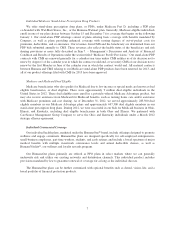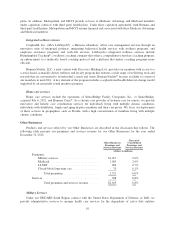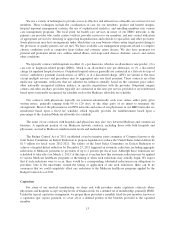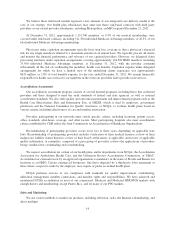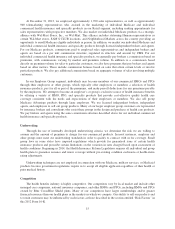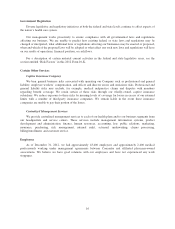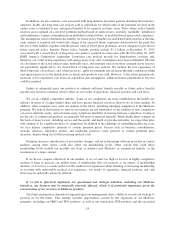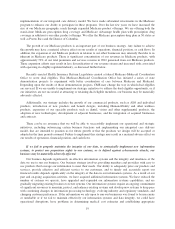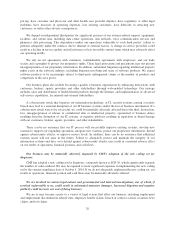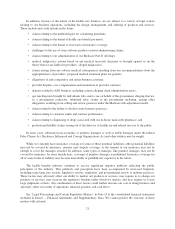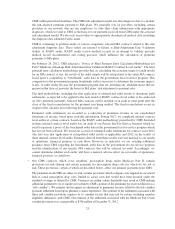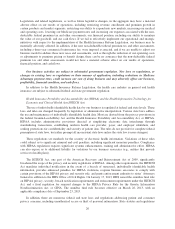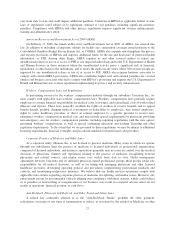Humana 2012 Annual Report Download - page 27
Download and view the complete annual report
Please find page 27 of the 2012 Humana annual report below. You can navigate through the pages in the report by either clicking on the pages listed below, or by using the keyword search tool below to find specific information within the annual report.ITEM 1A. RISK FACTORS
If we do not design and price our products properly and competitively, if the premiums we charge are
insufficient to cover the cost of health care services delivered to our members, if we are unable to implement
clinical initiatives to provide a better health care experience for our members, lower costs and appropriately
document the risk profile of our members, or if our estimates of benefits expense are inadequate, our
profitability may be materially adversely affected. We estimate the costs of our benefits expense payments, and
design and price our products accordingly, using actuarial methods and assumptions based upon, among
other relevant factors, claim payment patterns, medical cost inflation, and historical developments such as
claim inventory levels and claim receipt patterns. These estimates, however involve extensive judgment, and
have considerable inherent variability because they are extremely sensitive to changes in payment patterns
and medical cost trends.
We use a substantial portion of our revenues to pay the costs of health care services delivered to our
members. These costs include claims payments, capitation payments to providers (predetermined amounts paid
to cover services), and various other costs incurred to provide health insurance coverage to our members. These
costs also include estimates of future payments to hospitals and others for medical care provided to our members.
Generally, premiums in the health care business are fixed for one-year periods. Accordingly, costs we incur in
excess of our benefit cost projections generally are not recovered in the contract year through higher premiums.
We estimate the costs of our future benefit claims and other expenses using actuarial methods and assumptions
based upon claim payment patterns, medical inflation, historical developments, including claim inventory levels
and claim receipt patterns, and other relevant factors. We also record benefits payable for future payments. We
continually review estimates of future payments relating to benefit claims costs for services incurred in the
current and prior periods and make necessary adjustments to our reserves. However, these estimates involve
extensive judgment, and have considerable inherent variability that is sensitive to payment patterns and medical
cost trends. Many factors may and often do cause actual health care costs to exceed what was estimated and used
to set our premiums. These factors may include:
• increased use of medical facilities and services, including prescription drugs;
• increased cost of such services;
• our membership mix;
• variances in actual versus estimated levels of cost associated with new products, benefits or lines of
business, product changes or benefit level changes;
• changes in the demographic characteristics of an account or market;
• changes or reductions of our utilization management functions such as preauthorization of services,
concurrent review or requirements for physician referrals;
• changes in our pharmacy volume rebates received from drug manufacturers;
• catastrophes, including acts of terrorism, public health epidemics, or severe weather (e.g. hurricanes
and earthquakes);
• the introduction of new or costly treatments, including new technologies;
• medical cost inflation; and
• government mandated benefits or other regulatory changes, including any that result from Health
Insurance Reform Legislation.
Key to our operational strategy is the implementation of clinical initiatives that we believe provide a better
health care experience for our members, lower these costs, and appropriately document the risk profile of our
members. Our profitability and competitiveness depend in large part on our ability to appropriately manage
health care costs through, among other things, the application of medical management programs such as our
chronic care management program.
17


